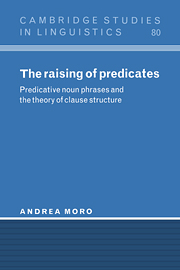Book contents
- Frontmatter
- Contents
- Acknowledgments
- Introduction: four apparently unrelated empirical domains
- 1 The anomaly of copular sentences: the raising of predicates
- 2 The syntax of ci
- 3 Are there parameters in semantics? The defining properties of existential sentences
- 4 The ‘quasi-copula’: the role of finite clauses in seem-sentences
- 5 A view beyond: unaccusativity as an epiphenomenon
- Appendix: a brief history of the copula
- Notes
- References
- Index
Appendix: a brief history of the copula
Published online by Cambridge University Press: 10 September 2009
- Frontmatter
- Contents
- Acknowledgments
- Introduction: four apparently unrelated empirical domains
- 1 The anomaly of copular sentences: the raising of predicates
- 2 The syntax of ci
- 3 Are there parameters in semantics? The defining properties of existential sentences
- 4 The ‘quasi-copula’: the role of finite clauses in seem-sentences
- 5 A view beyond: unaccusativity as an epiphenomenon
- Appendix: a brief history of the copula
- Notes
- References
- Index
Summary
Mirrors and the copula are abominable because they multiply the number of people
J. L. BorgesThe meaning(s) of ‘copula’
There are terms in the history of science which, from the time that they were first adopted, have never been dropped. This is the case with such well-known terms as ‘atom’ or ‘energy’ or ‘gene’. In reality, however, we all know that this continuity is only superficial; in the course of time terms of this type inevitably change their original meaning. The result of this is that, even though in most cases we are prepared to acknowledge that some basic core intuition, contained in the term in question when it was originally coined, has indeed survived, we are accustomed to treating such terms with great care: in particular, before they can be used in any sort of scientific treatise, exhaustive definitions have to be given.
From this point of view, linguistics is no different from any other field of inquiry. Terms like ‘verb’ or ‘subject’ or ‘negation’ may well not mean the same thing now as they did at earlier stages in the study of language. There is therefore a risk of generating confusion, especially in studies that draw on more than one theoretical tradition.
In this brief appendix my aim is to investigate the term ‘copula’: I will attempt to show that, in its common use, it conceals at least three distinct traditions which have been taken over by modern linguistics complete with their various inconsistencies and obscurities.
A brief survey of three major approaches
Three major approaches will be briefly illustrated here. In the first section, Aristotle's theory will be presented insofar as it can be reconstructed in its essential lines from the De Interpretatione.
- Type
- Chapter
- Information
- The Raising of PredicatesPredicative Noun Phrases and the Theory of Clause Structure, pp. 248 - 261Publisher: Cambridge University PressPrint publication year: 1997



